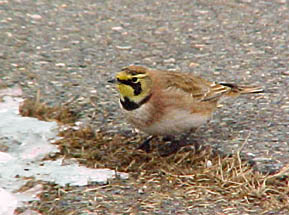 February
is a weird month. It's usually the snowiest month of
winter and yet it's also when the first obvious signs of
spring appear. Ducks definitely think it's spring. Male
common goldeneyes are displaying for all they're worth
wherever they can find a patch of open water.
February
is a weird month. It's usually the snowiest month of
winter and yet it's also when the first obvious signs of
spring appear. Ducks definitely think it's spring. Male
common goldeneyes are displaying for all they're worth
wherever they can find a patch of open water.
The goldeneye courtship thing
amazes me. The male touches his head to the middle of his
back, pointing his bill straight up at the sky. How does
he stretch his neck that far? Are their necks made of
rubber? And why are females supposed to be impressed by
this? Do contortionists make better fathers?
The goldeneyes were the most active
today in the unfrozen stretch of the Parker River near
the Newbury town boat launch. There were bunches of
buffleheads and red breasted mergansers in the same spot.
There isn't that much open water yet. Red breasted
mergansers are impressive at courting too but today all
the males seemed to be asleep. The buffleheads all dove
the instant I would get the binoculars focused on them as
if they knew I was watching them. It was pretty funny.
They seemed mostly focused on feeding.
On the refuge I noticed tree
sparrows feeding on the edge of the road singly or in
pairs for almost its whole length. The only place I saw
the tree sparrows in a loose flock was at the Hellcat
parking lot where it looked like somebody had been
feeding them. There were what looked like bread crumbs
spread around. I'd been wondering if the tree sparrows
were beginning to pair off already. But that theory
started to fall apart when I saw one "pair" of a tree
sparrow with a white throated sparrow. The little flock
at Hellcat was mixing with an American robin and three
black-capped chickadees. They all took off together
whenever a blue jay or a crow appeared. One tree sparrow
was pecking at a huge bread crumb about three quarters of
its own size when a blue jay landed next to it. The other
sparrows and their friends took off, but this one kept
pecking at the giant bread crumb until the blue jay
snatched it away. Only then did the tiny tree sparrow
flee to the other side of a snow bank.
The sky was unbelievably heavy and
white. All afternoon it looked like the snow would start
any minute, but it didn't start until after 4:00 PM. I
started to think maybe the storm wasn't going to come
this far north. There's still plenty of snow on the
ground from Friday's storm, more at my house than at the
refuge. Along with the white sky and the ice on the marsh
and rivers it all makes a weird kind of monochrome
landscape.
Two short eared owls actively
hunted over the dunes and one perched on a cedar tree
swiveling its head from side to side rapidly scanning for
signs of something to hunt. Oddly, I saw not one single
rough legged hawk anywhere. No harriers either.
The same three horned larks that
Nancy and I watched eating grass from the cracks in
parking lot 1 yesterday were eating grass from the cracks
in parking lot 1 again today. They line up in a row along
the same crack and just peck away. Sometimes their
movements even synchronized. It was pretty funny. The
horned larks at Salisbury Beach were more spread out,
like all over the place in the campground, the boat ramp,
the parking lot, the road ... everywhere. And on such a
monochrome day their yellow and black faces looked
positively gaudy.